 W
WA garde manger is a cool, well-ventilated area where cold dishes are prepared and other foods are stored under refrigeration. The person in charge of this area is known as the chef garde manger or pantry chef. Larger hotels and restaurants may have garde manger staff to perform additional duties, such as creating decorative elements of buffet presentation like ice carving and edible centerpieces.
 W
WAspic is a savoury gelatin dish made with a meat stock or consommé, set in a mold to encase other ingredients. These often include pieces of meat, seafood or eggs. Aspic is also sometimes referred to as aspic gelée or aspic jelly.
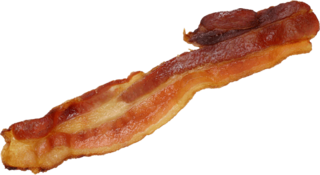 W
WBacon is a type of salt-cured pork made from various cuts, typically from the pork belly or from the less fatty back cuts. It is eaten on its own, as a side dish, or used as a minor ingredient to flavour dishes. Bacon is also used for barding and larding roasts, especially game, including venison and pheasant, and may also be used to insulate or flavour roast joints by being layered onto the meat. The word is derived from the Old High German Bahho, meaning "buttock", "ham" or "side of bacon", and is cognate with the Old French bacon. It may also be distantly cognate with modern German Bauch, meaning "abdomen, belly".
 W
WSausage casing, also known as sausage skin or simply casing, is the material that encloses the filling of a sausage. Natural casings are made from animal intestines or skin; artificial casings, introduced in the early 20th century, are made of collagen and cellulose. The material is then shaped via a continuous extrusion process – producing a single sausage casing of indefinite length – which is then cut into desired lengths, usually while the extrusion process continues.
 W
WCharcuterie is a French term for a branch of cooking devoted to prepared meat products, such as bacon, ham, sausage, terrines, galantines, ballotines, pâtés, and confit, primarily from pork.
 W
WCuring is any of various food preservation and flavoring processes of foods such as meat, fish and vegetables, by the addition of salt, with the aim of drawing moisture out of the food by the process of osmosis. Because curing increases the solute concentration in the food and hence decreases its water potential, the food becomes inhospitable for the microbe growth that causes food spoilage. Curing can be traced back to antiquity, and was the primary method of preserving meat and fish until the late-19th century. Dehydration was the earliest form of food curing. Many curing processes also involve smoking, spicing, cooking, or the addition of combinations of sugar, nitrate, and nitrite.
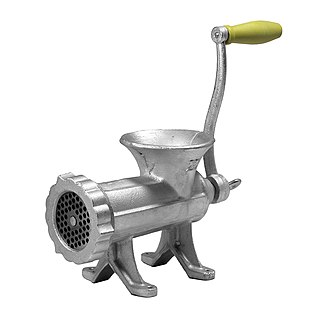 W
WA meat grinder is a kitchen appliance for fine chopping ('mincing') and/or mixing of raw or cooked meat, fish, vegetables or similar food. It replaces tools like the mincing knife. The food to be minced is placed into a funnel, which sits on top of the grinder. From there, the material enters a horizontal screw conveyor; the screw conveyor may be hand-cranked or powered by an electric motor. The screw squashes and mixes the food. At the end of the screw, the food is passed through a fixed plate, where it exits the machine. The fineness of the minced food depends on the size of the holes in the plate.
 W
WFood drying is a method of food preservation in which food is dried. Drying inhibits the growth of bacteria, yeasts, and mold through the removal of water. Dehydration has been used widely for this purpose since ancient times; the earliest known practice is 12,000 B.C. by inhabitants of the modern Middle East and Asia regions. Water is traditionally removed through evaporation, although today electric food dehydrators or freeze-drying can be used to speed the drying process and ensure more consistent results.
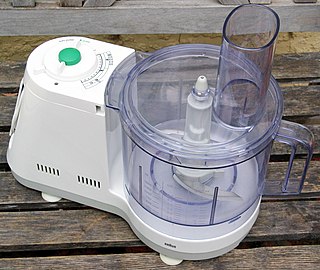 W
WA food processor is a kitchen appliance used to facilitate repetitive tasks in the preparation of food. Today, the term almost always refers to an electric-motor-driven appliance, although there are some manual devices also referred to as "food processors".
 W
WForcemeat is a uniform mixture of lean meat with fat made by grinding, sieving, or puréeing the ingredients. Forcemeats are used in the production of numerous items found in charcuterie, including quenelles, sausages, pâtés, terrines, roulades, and galantines. Forcemeats are usually produced from raw meat, except in the case of a gratin. Meats commonly used include pork, fish, seafood, game meats, poultry, game birds, veal, and pork livers. Pork fatback is preferred as a fat, as it has a somewhat neutral flavor.
 W
WIn French cuisine, galantine is a dish of de-boned stuffed meat, most commonly poultry or fish, that is poached and served cold, coated with aspic. Galantines are often stuffed with forcemeat, and pressed into a cylindrical shape. Since deboning poultry is thought of as difficult and time-consuming, this is a rather elaborate dish, which is often lavishly decorated, hence its name, connoting a presentation at table that is galant, or urbane and sophisticated. In the later nineteenth century the technique's origin was already attributed to the chef of the marquis de Brancas.
 W
WHam is pork from a leg cut that has been preserved by wet or dry curing, with or without smoking. As a processed meat, the term "ham" includes both whole cuts of meat and ones that have been mechanically formed.
 W
WAn hors d'oeuvre, appetizer or starter is a small dish served before a meal in European cuisine. Some hors d'oeuvres are served cold, others hot. Hors d'oeuvres may be served at the dinner table as a part of the meal, or they may be served before seating, such as at a reception or cocktail party. Formerly, hors d'oeuvres were also served between courses.
 W
WIce sculpture is a form of sculpture that uses ice as the raw material. Sculptures from ice can be abstract or realistic and can be functional or purely decorative. Ice sculptures are generally associated with special or extravagant events because of their limited lifetime.
 W
WLactobacillus is a genus of Gram-positive, aerotolerant anaerobes or microaerophilic, rod-shaped, non-spore-forming bacteria. Until March 2020, the genus Lactobacillus comprised over 260 phylogenetically, ecologically, and metabolically diverse species; a taxonomic revision of the genus in 2020 assigned lactobacilli to 25 genera.
 W
WNitrate is a polyatomic ion with the chemical formula NO−3. Salts containing this ion are called nitrates. Nitrates are common components of fertilizers and explosives. Almost all inorganic nitrates are soluble in water. An example of an insoluble nitrate is Bismuth oxynitrate.
 W
WThe nitrite ion has the chemical formula NO−2. Nitrite is widely used throughout chemical and pharmaceutical industries. Nitrite anion is a pervasive intermediate in the nitrogen cycle in nature. The name nitrite can also refer to organic compounds with the -ONO group, which are esters of nitrous acid.
 W
WNitrosamines (or more formally N-Nitrosamines) are organic compounds of the chemical structure R2N−N=O, where R is usually an alkyl group. They feature a nitroso group (NO+) bonded to a deprotonated amine. Most nitrosamines are carcinogenic.
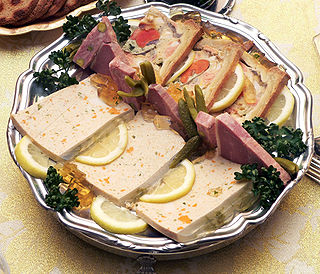 W
WPâté is a paste, pie or loaf filled with a forcemeat. Common forcemeats include ground meat from pork, poultry, fish or beef, fat, vegetables, herbs, spices and either wine or brandy.
 W
WA quenelle is a mixture of creamed fish or meat, sometimes combined with breadcrumbs, with a light egg binding, formed into an egg-like shape, and then cooked. The usual preparation is by poaching. Formerly, quenelles were often used as a garnish in haute cuisine. Today, they are more commonly served sauced as a dish in their own right. Similar items are found in many cuisines.
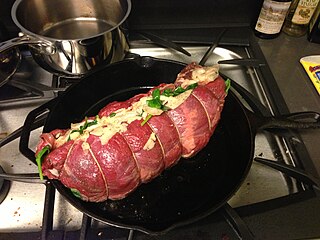 W
WA roulade (/ruːˈlɑːd/) is a dish of filled rolled meat or pastry. Roulade can be savory or sweet. Swiss roll is an example of a sweet roulade. Traditionally found in various European cuisines, the term roulade originates from the French word "rouler", meaning "to roll".
 W
WA salad is a dish consisting of mixed pieces of food, sometimes with at least one raw ingredient. It is often dressed, and is typically served at room temperature or chilled, though some can be served warm.
 W
WA sausage is a type of meat product usually made from ground meat, often pork, beef, or poultry, along with salt, spices and other flavourings. Other ingredients such as grains or breadcrumbs may be included as fillers or extenders. Some sausages include other ingredients for flavour.
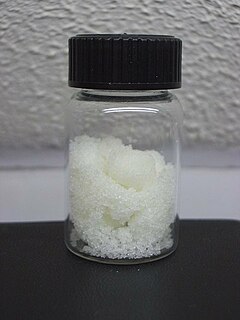 W
WSodium nitrite is an inorganic compound with the chemical formula NaNO2. It is a white to slightly yellowish crystalline powder that is very soluble in water and is hygroscopic. From an industrial perspective, it is the most important nitrite salt. It is a precursor to a variety of organic compounds, such as pharmaceuticals, dyes, and pesticides, but it is probably best known as a food additive used in processed meats and (in some countries) in fish products.
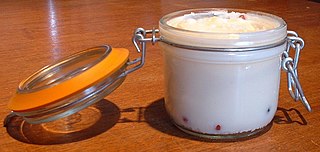 W
WTallow is a rendered form of beef or mutton fat, primarily made up of triglycerides. It is solid at room temperature. Unlike suet, tallow can be stored for extended periods without the need for refrigeration to prevent decomposition, provided it is kept in an airtight container to prevent oxidation.
 W
WA terrine, in traditional French cuisine, is a loaf of forcemeat or aspic, similar to a pâté, that is cooked in a covered pottery mold in a bain-marie. Modern terrines do not necessarily contain meat or animal fat, but still contain meat-like textures and fat substitutes, such as mushrooms and pureed fruits or vegetables high in pectin. They may also be cooked in a wide variety of non-pottery terrine moulds, such as stainless steel, aluminium, enameled cast iron, and ovenproof plastic.